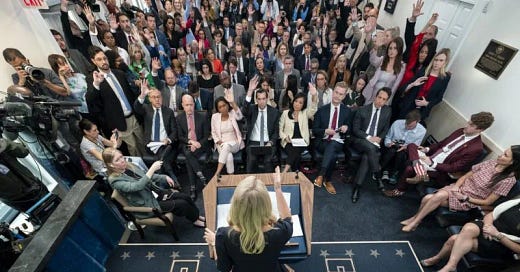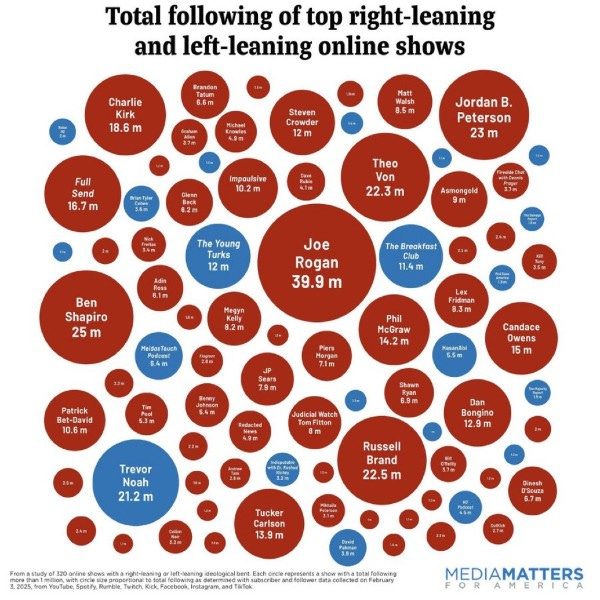Is the Right-Wing News Bubble Too Big to Burst?
There are hopeful signs of combatting misinformation but to do so requires a different understanding of how they work.
We've all experienced that frustrating moment at the dinner table, a relative confidently asserts something that seems to exist in an entirely different reality from our own. It's not just disagreement; it's as if we're inhabiting different informational universes. This phenomenon extends far beyond family gatherings. The expanding right-wing media ecosystem, particularly as it intertwines with state power under the Trump administration, has created not just partisan disagreement but distinct epistemic communities, parallel realities seemingly impervious to contradiction. Yet before we surrender to cynicism, there are compelling reasons to believe these bubbles may be more permeable than they appear.
Information bubbles aren't simply about bias or preference; they're intricate reality-construction projects. What makes them so powerful isn't their falsehood but their coherence. When I’ve given speeches on combatting misinformation, I’ve always pointed out that this is not a new phenomenon in our country. Benjamin Franklin peddled in misinformation. William Randolph Hearst made a fortune in the ‘fake news’ business and even got us into the ‘Spanish American War’ under completely false pretenses, or “yellow journalism” as it was called. Even Joseph Pulitzer, after whom the famed award is named, was a renowned fabricator of news. That is, he was a liar. These ecosystems sustain themselves through elegant feedback loops: audiences, content creators, and politicians reinforce desired narratives while methodically dismissing contradictory voices.
And let’s not kid ourselves, there’s nothing organic about this. This is all the result of a deliberate, sophisticated effort by billionaires (X and Fox News are huge foreign-owned media platforms central to this strategy) and outside actors with agendas not necessarily in line with our country’s.
The right-wing media ecosystem has demonstrated particular resilience thanks to our all-too-human tendency to treat contradicting information not as correction but as conspiracy. This protective mechanism becomes nearly impenetrable when state power endorses it, potentially transforming partisan media bubbles into state-adjacent information systems whose claims carry the weight of official authority.
The Trump administration's approach to media relations reveals a sophisticated understanding of how information ecosystems function. CNN's February 2025 reporting documented how the White House has systematically restructured media access, sidestepping the traditionally independent White House Correspondents' Association in favor of direct administration control over pool arrangements. The Associated Press, which coordinated pool coverage through Republican and Democratic administrations alike, finds itself increasingly marginalized, while administration-friendly outlets receive unprecedented access.
The Guardian's investigation from May 2025 paints an even more troubling picture. Press Secretary Karoline Leavitt has established a new media hierarchy within the briefing room, granting prime positions to partisan commentators, including some previously removed from social media platforms for spreading misinformation. Meanwhile, outlets perceived as critical report increasingly insurmountable obstacles to obtaining credentials or accessing officials. The message is clear - loyalty trumps scrutiny.
This approach extends beyond the White House briefing room. Plans to overhaul Voice of America and install figures like Kari Lake in leadership positions at government-funded media organizations suggest a comprehensive strategy to reshape the broader media environment into a more administration-friendly form.
Recent Pew Research findings (May 8, 2025) reveal a profound shift in who trusts what, and why. Republicans now demonstrate dramatically increased trust in both social media platforms and ideologically aligned news sources, a striking reversal from traditional conservative skepticism toward digital information. This isn't merely partisan preference but fundamentally different frameworks for deciding what information deserves belief.
Particularly telling is how increased social media trust correlates with decreased exposure to mainstream news sources. As Republicans report higher confidence in social media, they simultaneously retreat from traditional news environments. This creates a siloed conversation among the like-minded that often produces increasingly extreme positions over time.
Looking at similar media transformations abroad offers both warnings and reasons for hope. Poland and Hungary demonstrate how state-reinforced information ecosystems can achieve remarkable durability when supported by official institutions. Government-aligned media in both countries constructed alternative information environments that proved stubbornly resistant to contradiction despite clear factual discrepancies.
Yet, history also suggests these bubbles have breaking points. The collapse of state media systems in Eastern Europe following Soviet dissolution reminds us that even tightly controlled information environments eventually face sustainability challenges when reality diverges too dramatically from sanctioned narratives. Similarly, contemporary authoritarian media systems in Turkey and Russia reveal persistent "information leakage" despite sophisticated control mechanisms.
Beyond historical examples, there is grounds for cautious optimism. While partisan media consumers strongly resist contradictory information, this resistance isn't uniform across topics. When information pertains to immediate personal concerns rather than abstract ideological positions, cross-bubble information flows more freely. We might disagree about political theory but find common ground on practical matters affecting our daily lives.
The Reuters Institute for the Study of Journalism similarly found that media bubbles may be more porous than we assume. Their analysis reveals that even highly partisan news consumers encounter significant information from outside their preferred ecosystem, though they typically reframe this information to align with existing beliefs. This reframing process, while problematic, nevertheless indicates information transmission across bubble boundaries.
Perhaps most encouragingly, younger news consumers show greater adaptability in navigating multiple information sources simultaneously. Rather than inhabiting one bubble exclusively, they access diverse sources while developing more sophisticated ways to assess credibility than previous generations.
Democratic institutions have demonstrated considerable resilience when confronting information challenges. Journalism organizations have developed increasingly sophisticated strategies for bursting partisan bubbles, including collaborative fact-checking, strategic source diversification, and narrative approaches that emphasize shared values rather than partisan frames. These approaches recognize that effective communication across bubbles requires more than simply correcting facts; it demands engaging underlying values and concerns.
Educational institutions have similarly evolved more nuanced approaches to media literacy that go beyond simplistic "fake news" warnings to address deeper questions of source methodology and critical analysis. These approaches foster the capacity to assess information based on evidence quality rather than tribal affiliation.
Most importantly, democratic citizenship itself demonstrates remarkable resilience. Citizens possess greater capacity for critical information assessment than is often acknowledged, particularly when given appropriate tools and contexts for deliberation. When presented with factual information in accessible formats that respect their intelligence and agency, people frequently transcend partisan filters.
Whether the right-wing media bubble is "too big to burst" ultimately depends less on technology or institutions than on our collective commitment to shared standards of evidence and truth. While current trends raise legitimate concerns, history suggests truth maintains a persistent advantage when citizens possess both the will and capacity to distinguish between reliable and unreliable information. Democratic societies have repeatedly demonstrated a remarkable capacity for self-correction when confronting information distortion—a capacity that remains available to us today, if we choose to exercise it.






Very thoughtful, Mike, and I hope your optimism is correct. My thought is reality bites: when folks are hit with a recession, inflation or healthcare cuts the bubble must burst--all those 'media conspiracy' dismissals will no longer hold when the facts on the ground become obvious.
Info bubbles are burst when actions and events are so egregious that they reveal common ground between bubbles, were before none was perceived. This creates a line beyond which perpetrators of the egregious actions hazard to cross. There is a lot of "dancing" on or near this line right now, and more and more people are being forced to look beyond the boundaries of their bubble(s).